From Tampa Bay, Florida to Brownsville, Texas the U.S. Gulf Ports have experienced a growth in business — some of it due to the shift from West Coast Ports to the Gulf — and some of the growth is a result of prudent investments in port infrastructure to capture the opportunities.
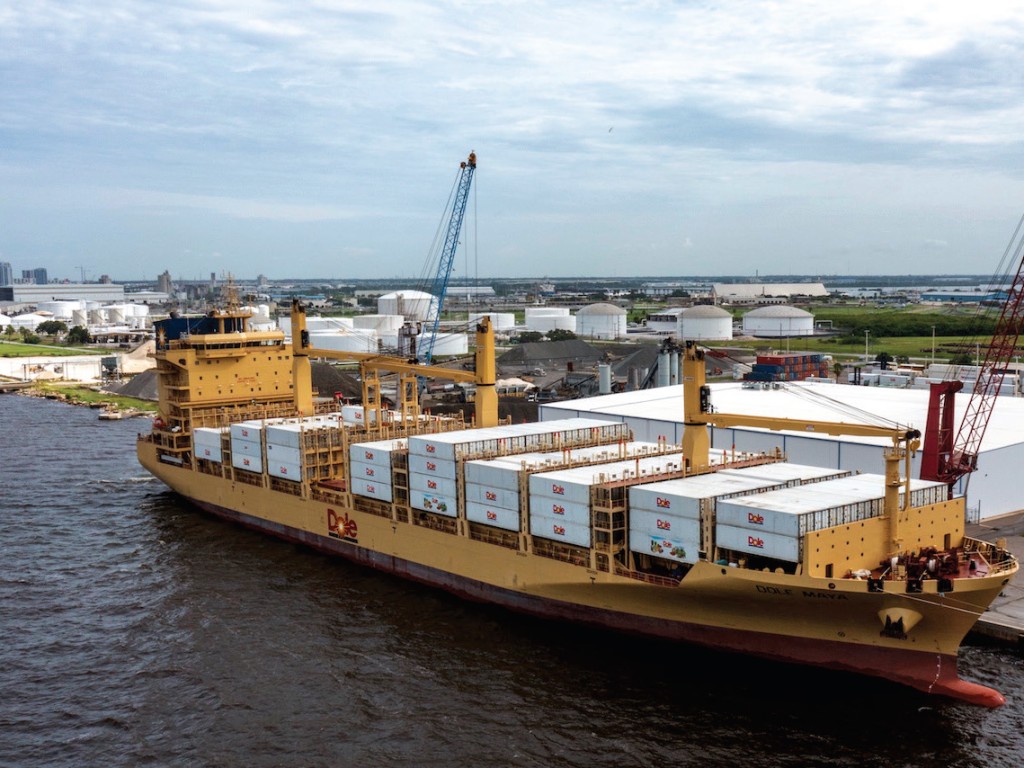
Port Tampa Bay, FL
In late February, Port Tampa Bay clinched an important infrastructure deal. Tradepoint Atlantic, which owns a 3,300-acre global multimodal logistics hub and industrial center on Sparrows Point in the Port of Baltimore, announced that the Port Tampa Bay’s Board of Commissioners approved a lease agreement with “Tradepoint Tampa” for 35 acres of land to build a new trans-load warehouse distribution facility. Under the terms of a 40-year lease agreement, Tradepoint Tampa will design, construct, and operate an approximately 500,000 square foot facility for the trans-loading of cargo between ocean containers, trucks, and rail cars. The new trans-load facility will be located on Hooker’s Point adjacent to the port’s container terminal, which is also being expanded with additional paved storage, cranes, and a new gate complex, as well as the port’s on-dock cold storage facility.
And this isn’t the only new business in the port. The port is also expanding by leaps and bounds and got a big boost from the US DOT. Port Tampa Bay will receive $12.6 million in grant funding from the US DOT to expand and diversify a berth at Port Redwing. The port’s funding allocation is part of $1.5 billion in grant funding made available through the Rebuilding American Infrastructure with Sustainability and Equity (RAISE) discretionary grant program. Tampa will use RAISE funding to create Berth 301 at the satellite facility, Port Redwing. The new berth will provide room for a third large ship to be worked at the port. Additional private investment and investment from Port Tampa Bay will be added to the grant’s funds. Besides Redwing, there is a terminal expansion underway which includes increased storage to 97 acres from 67 acres, berth expansion to 4,500 feet from 3,200, an additional new gate, and three new gantry cranes.
The port anticipates completion of $78.3 million in capital improvement projects in 2023. At $35.4 million, Hooker’s Point Development is the largest component of the capital plan and includes berth and road improvements.
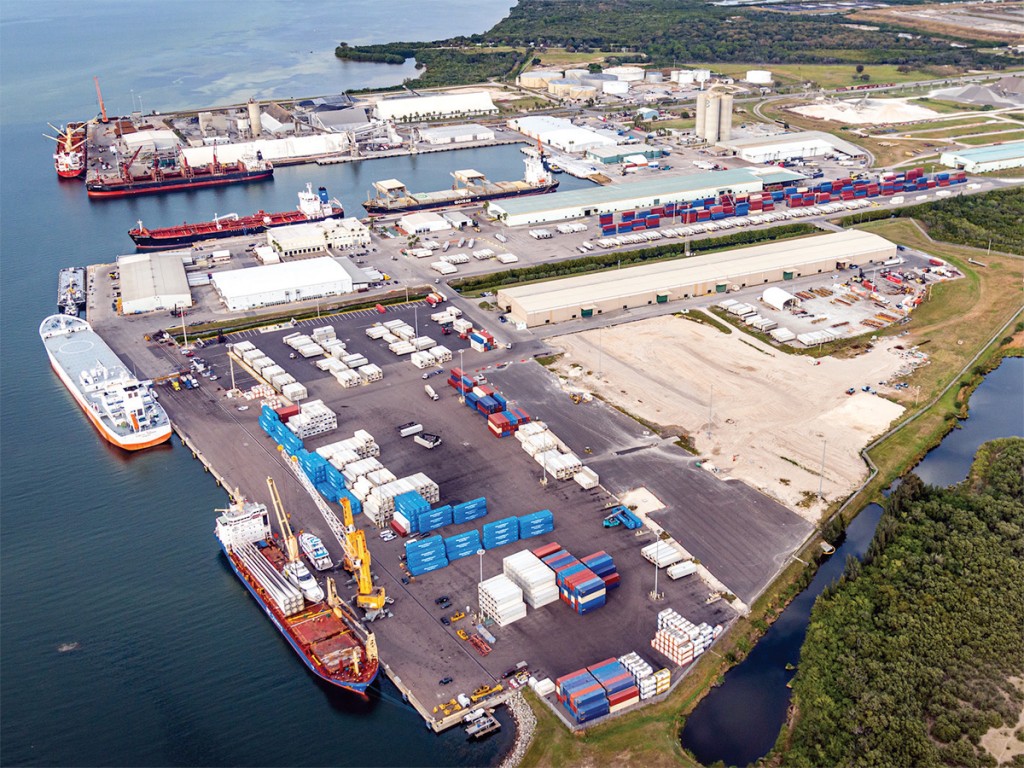
SeaPort Manatee, FL
SeaPort Manatee, which had a record breaking year in 2022, has embarked on a strategy to leverage the port’s location as a freight gateway to Florida with connection to Latin America and the Panama Canal. In February the port inked a deal with Chile-based Agencias Universales S.A. (Agunsa) to operate a terminal through a new subsidiary called Agunsa Manatee Terminal (AMT). In press reports, Maximiliano Urenda, Chief Development Officer Grupo Empresas Navieras (Agunsa) said of the acquisition, “Our strategy in the United States is to drive growth both organically and inorganically. On the one hand, we are looking to strengthen our existing businesses in logistics services, trucking and FFW. On the other hand, we are looking to expand our presence through the acquisition of port terminals.” Adding, “We see great potential in the purchase of Manatee, a port with consistent growth in all types of cargo and a strategic location as the closest deep-water port to the Panama Canal. With excellent rail and road connections, cargo can reach important urban areas in a short time.”
The new terminal has an open area of 280,000 sqm, 8,500 tonnes of storage capacity in silos.
The port is also engaged in improving its infrastructure, as Reggie Bellamy, chairman of the Manatee County Port Authority pointed out, “Working closely with industry partners in sustaining record levels of commerce, SeaPort Manatee continues to enhance its infrastructure, including through ongoing expansion of dockside container yard facilities, while offering more than 5,000 acres of on-and near-port properties for future development.” Among the improvements made during 2022, SeaPort Manatee and terminal operator Logistec USA Inc., (a subsidiary of Logistec Corp) added two new Konecranes Gottwald Generation 6 mobile harbor cranes. The eco-efficient cranes arrived at SeaPort Manatee on April 22, 2022, via trans-Atlantic vessel voyage from Germany. Each of the cranes is capable of lifting loads of as many as 125 metric tons, and the two units combine to offer a tandem lift capability of more than 200 metric tons – the most at any Florida seaport.
In March, SeaPort Manatee added a much needed liner service to Central America. The new direct liner service of Oceanus Line provides an efficient all-water link between key seaports of Mexico and Colombia and SeaPort Manatee on the Florida Gulf Coast and Port Freeport on the Texas Gulf Coast, utilizing the 1,740 TEU containership X-Press Cotopaxi.
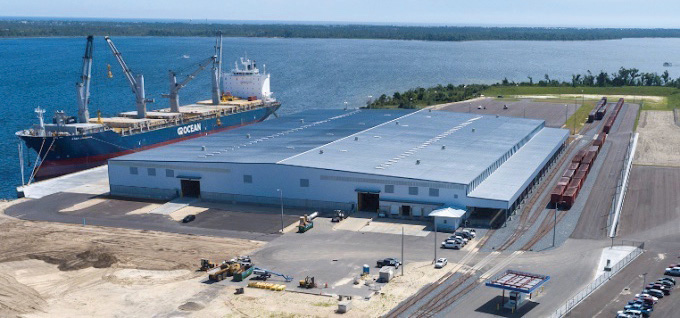
Port Panama City, FL
Port Panama City set an all-time record high of 2.03 million tons of cargo – a four percent year-over-year growth, eclipsing the 1.95 million tons handled in FY 2021. And it wasn’t just cargo, as Port Panama City also set a revenue record of $19.04 million in FY 2022, a 9% increase over FY 2021.
Port Panama City, like other Florida ports, benefited from a clear terminal and a shift in freight as shippers tried to dodge supply chain disruptions occurring in other parts of the country – notably the West Coast. Alex King, executive director, Port Panama City noted in his review of the results, “While much of the country spent last year dealing with supply chain disruptions, Port Panama City was focused on securing additional cargo that would normally move through gateway ports in other states. Our port has become an attractive option for breakbulk forest products and other cargoes.”
In many respects Port Panama City became a “breakbulk” port alternative for many shippers. Indeed, Port Panama City handled more than 450,000 tons of breakbulk forest products and lumber in 2022, with 230,000 tons of that cargo moving through the East Terminal which opened for operation in 2020.
Besides the East Terminal with its 260,000 sq/ft warehouse and 900 foot bulkhead, the Port has made a number of recent investments in its infrastructure, these include: a biomass bulk dome on the 138-acre West Terminal; an Intermodal Distribution Center (IDC) Site Development for additional on-site tenants; development of a FedEx Ground Regional Distribution Center at the IDC and a 70,000 sq/ft on port Container Freight Station (CFS) West Terminal to the growth in container business with Mexico.
Mexico has been another bright spot for the port. In 2022 King represented the Florida Ports Council on an Economic Trade Mission to Mexico. For Port Panama City that has translated into a 10% increase in trade.
In January 2023, the Panama City Port Authority board approved a plan to expand the East Terminal by adding an additional 27 acres to the existing 54 acres. James Cook, the board chairman, elaborated on the plan saying it would double the terminal’s capacity. The additional land would enable the berth to be expanded to 900 feet. Currently, the terminal can handle one-ship and averages only one or two ship calls a month. The pier expansion would allow the port to handle two ships at a time and also provide the space for more warehousing.
Port of Mobile, AL
The Port of Mobile, like many of the Gulf ports, posted a record year in 2022. The Alabama Port Authority said the Port of Mobile tallied 563,191 TEUs in 2022 — the ninth year the Port of Mobile posted double-digit growth since 2009. The 563,191 TEUs were 11% over 2021, another very good year for the port. However, with tepid demand, container demand in the U.S. has fallen, with Mobile seeing a 7.8% decline through April year-to-date vs. 2022.
Both pricing and demand continue to be depressed globally, and rates have subsided from peaks seen throughout the pandemic. Despite the overall decline, some container market segments have shown strong growth, including refrigerated containers, which have increased by 22% year-to-date in April and 44% year-over-year. Intermodal volumes have also seen growth of 58% year-to-date through April.
Intermodal rail volumes continued a 31-month record of triple-digit growth, ending the year at 142 percent over 2021. Additionally, the container terminal handled a record 312 vessels, an increase of 75 vessels from 2022.
In May 2022, the Alabama Port Authority also entered an agreement with APM Terminals which will add 32 acres to the existing 134-acre facility and boost the facility’s annual throughput capacity to one million TEUs in the Phase IV expansion. In addition to the terminal expansion and the harbor deepening and widening project, the Alabama Port Authority plans to develop logistics facilities in Mobile and open a new inland intermodal facility served by CSX in Montgomery, Ala. These projects are set to begin operation in 2025.
Other planned investments include constructing a fly-over bridge to create on-dock rail access at the container terminal, modernizing general cargo piers, and developing an inland intermodal facility in North Alabama.
In March 2023, Enstructure, a leading U.S. marine terminal and logistics company, announced it has acquired Richardson Companies. Richardson, a breakbulk specialist, operates approximately one million square feet of industrial warehousing in Mobile, Houston, Baytown, and Freeport. With the acquisition, Enstructure will operate twenty terminals along the Gulf Coast, East Coast, and Inland River System with over five million square feet of industrial warehouse capacity.
Besides the container terminal the Port of Mobile boasts a unique rail connection to Mexico. CG Railway, LLC (CGR), was established over 20 years ago as a Class III railroad to provide a rail route between the US, Canada, and Central & Southern Mexico and now operates as a joint venture of Genesee & Wyoming Inc. (GW Rail) and SEACOR Holdings Inc. The CGR operates a unique connection of Mobile to Coatzacoalcos, Mexico rail-ferry services to Central America. CGR deploys two double-deck 590-foot ro/ro rail ferries, each with a capacity of 135 railcars on the route. Direct interchange in the U.S. railroads with AGR, ALE, CN, CSXT, NS and TASD (connecting to BNSF, KCS, MSE, UP and an array of other Class 1 and shortlines) and in Mexico with FSRR (connecting to FCCM/FIT, FXE, KCSM, and TFVM). Port-to-Port transit time for the rail-ferry service is three days.
Port of Pascagoula, MS
The Jackson County Port Authority, which manages the Port of Pascagoula, has appointed a new Port Director. With the retirement of Mark McAndrews on June 30, 2023, after 22 years as the Port Director, the Jackson County Port Authority Board of Commissioners selected Bo Ethridge as the Port Director effective May 1, 2023. Ethridge previously held the positions of the Director of Business Development & Foreign Trade Zone No. 2 for the Port of New Orleans and the Port Director of the Hancock County Port and Harbor Commission.
Last November the port celebrated the opening of Enviva Inc, marine export terminal. Enviva, the largest producer of woody biomass (largely wood pellets), has invested heavily in the region.
Since 2019, the Port Authority and Enviva have invested over $90 million to build the terminal at the Port of Pascagoula which can receive product by rail, barge, and truck as well as support Panamax-sized vessels. The facility includes two wood pellet storage domes with a total storage capacity of 90,000 metric tons. Enviva plans to export wood pellets, from the Port of Pascagoula terminal to power and utility customers across Asia, Europe, and the Caribbean – with a majority of the terminal’s future shipments slated for Japan. Enviva plans to double its production capacity over the next four to five years, from 6.2 million metric tons per year (MTPY) to approximately 13 million MTPY.
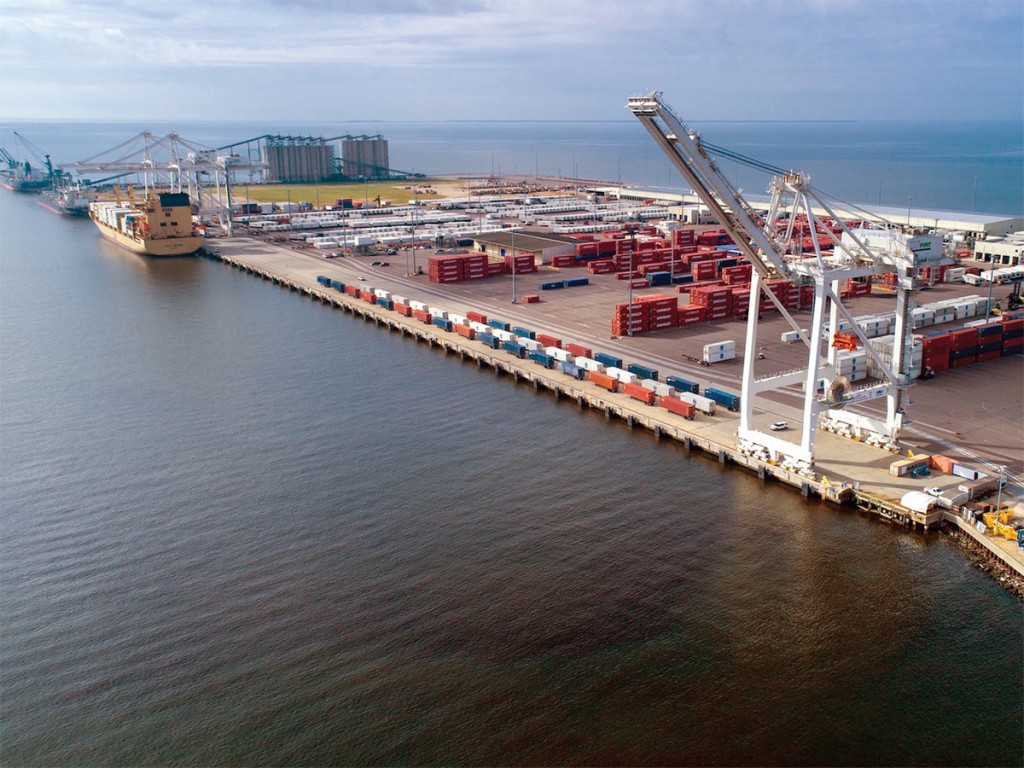
Gulfport, MS
In March, The Mississippi State Port Authority, the operating authority for the Port of Gulfports, has entered into a long-term lease and operating agreement with Ports America — Ports America acting as a licensed stevedore at Gulfport since 2006.
In September of 2022, the Port of Gulfport and Ports America entered into a Letter of Intent outlining their mutual intent to work together to increase commerce at the Port of Gulfport. Based on that Letter of Intent, the resulting lease and operating agreement which includes a twenty-year term with the option for two additional ten-year terms available to Ports America.
One major feature of the deal is a $43 million investment from Ports America to develop the port’s vacant Terminal 4 into a cargo-handling terminal. This includes a new ship-to-shore crane and surface improvements. This investment is in addition to Ports America’s recent acquisition of new cargo-handling equipment from Mississippi based manufacturers.
Ports America’s investment in the infrastructure and development of the Port of Gulfport, specifically Terminal 4, will drive an economic boost to the area. The addition of new business at the Port of Gulfport is expected to result in more longshoreman hours for the local ILA, and an increase in throughput for the port. The partnership should also result in increased ship traffic and provide a basis for the port’s ongoing project to deepen and widen the channel.
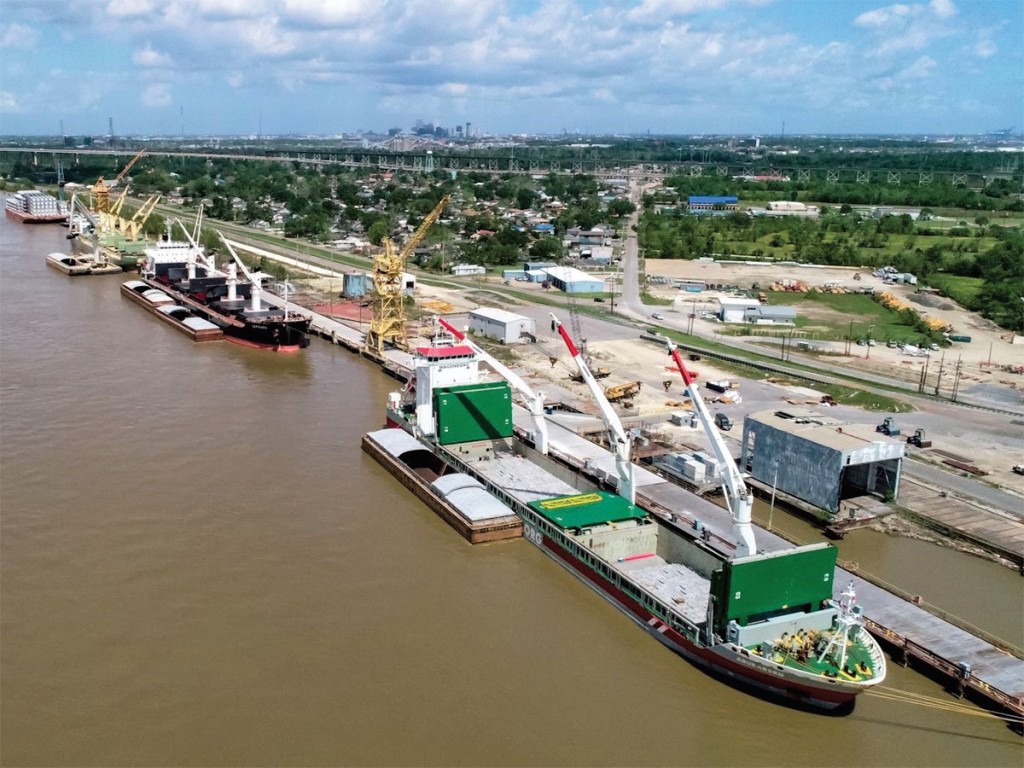
Port of So. Louisiana, LA
The Port of South Louisiana might just be the largest port — 239 million tons worth of largeness — that people know the least about…but that is all changing. And the change is well underway as noted by the March 1st ribbon cutting ceremony for the port’s official opening of their new state-of-the-art 30,000-square-foot headquarters that appropriately overlooks the Mississippi River. The three-story headquarters cost nearly $12 million to build and includes two stories of offices and meeting rooms and a ground-floor garage. The new headquarters marks the first time in the port’s history that the entire administration is located in a single building.
But the new look headquarters is only part of the story as the Port of South Louisiana is also rebranding itself as “Port SL.”
A contributing reason for Port SL’s cargo tonnage is grain. PortSL claims the title of America’s leading grain exporting port district. In 2022, the Port handled over 43 million tons of maize and more than 42 million tons of soybeans, enough to make it the largest argi-business port. These cargos along with other liquid and dry bulk commodities make up a majority of PortSL’s cargo mix.
But it is fair to say the PortSL is looking to expand its reach and one potential deal could be the cornerstone of the ambitious strategy.
Back in 2018 T Parker Host, a well-known terminal operating and stevedoring company, acquired the former Avondale Shipyard, which shutdown in 2014. Located at mile 108 on the Mississippi River, Host set to work redeveloping the site into the “Avondale Global Gateway.” The site includes huge acreage along the river, four berths, and draft range of 32-47 feet. Further Avondale offers immediate access to regional and interstate highway systems and is positioned at the interchange of six Class I railroads, providing the capability to distribute cargo in all directions. And in October of 2022 Host held the official grand opening of the Avondale Global Gateway.
On January 1st, 2023, Host agreed to sell the 254-acre logistics hub to Port SL for $445 million, with the idea the authority would manage the facility and Host would remain on as the stevedore. Host is also re-locating its corporate headquarters from Norfolk, Virginia to Avondale, a move that shows the company is in for the long haul.
But there is still a critical hurdle to be crossed before the deal is finalized. The funding for the Port SL’s acquisition would come through the issuing of bonds that would need the approval of the bond commission — a process currently underway. It is expected that the bond commission’s decision and indeed the approval of the deal itself will come sometime during the summer.
However, in the meantime Avondale is already attracting business. In March New Orleans-based Gulf Wind Technology (GWT) announced it is collaborating with Shell to establish a research, training, and technology demonstration program at GWT’s facility within the Avondale Global Gateway. Port of South Louisiana CEO Paul Matthews, said of the move, “When the Port of South Louisiana began to look at acquiring the transformed Avondale Global Gateway, we were not only impressed by the current activity on the property, but we also recognized the potential for future development, especially in the area of renewable energy. Today’s announcement from Gulf Wind Technology and Shell is confirmation that Avondale is open for business and attracting commerce and investment from the world’s most recognizable organizations. PortSL congratulates everyone involved in making today’s announcement possible. This is just the beginning.”

Port of New Orleans, LA
Back in early December of 2022, Louisiana Governor John Bel Edwards announced a partnership between the State of Louisiana, the Port of New Orleans (Port of NOLA), Ports America, Terminal Investment Limited (TIL) — part of the Mediterranean Shipping Company — to build $1.8 billion container terminal named the Louisiana International Terminal (LIT). Construction of the St. Bernard Parish site is expected to start in 2025 and the first berth to open by 2028. Ports America and TIL have committed $800 million in funding toward the project, with additional commitments coming from the Port of NOLA itself, as well as State and Federal funding sources. When fully completed, LIT is designed to have an annual capacity of 2 million TEUs. The proposed new facility will be taking advantage of the deeper 50-foot Lower Mississippi River Ship Channel and avoiding height restrictions from Mississippi River bridges further up the river. The bridge in question is the Crescent City Connection, which doesn’t have enough air-draft clearance to allow larger boxships to call at the current Napoleon Avenue facilities. Currently, the LIT project is in the two-to-three-year federal permitting process.
The port’s logic behind pushing for LIT is partly because of the competition from ports in neighboring states, like Texas and Alabama. And also because of the continuing shift in TEUs from the West Coast ports to the Gulf and Atlantic ports. In 2022 Port of NOLA handled around 430,000 TEUs down 12% from a big 2021, when congestion was heavy on the West Coast and diversions moved TEUs to Gulf and Atlantic ports. The port regularly posted over 500,000 TEUs a year prior to COVID. And even now with a tepid demand, the port’s figures still look good. NOLA reported a February [2023] box throughput 38,456 TEUs, a 33% increase compared to the same period last year.
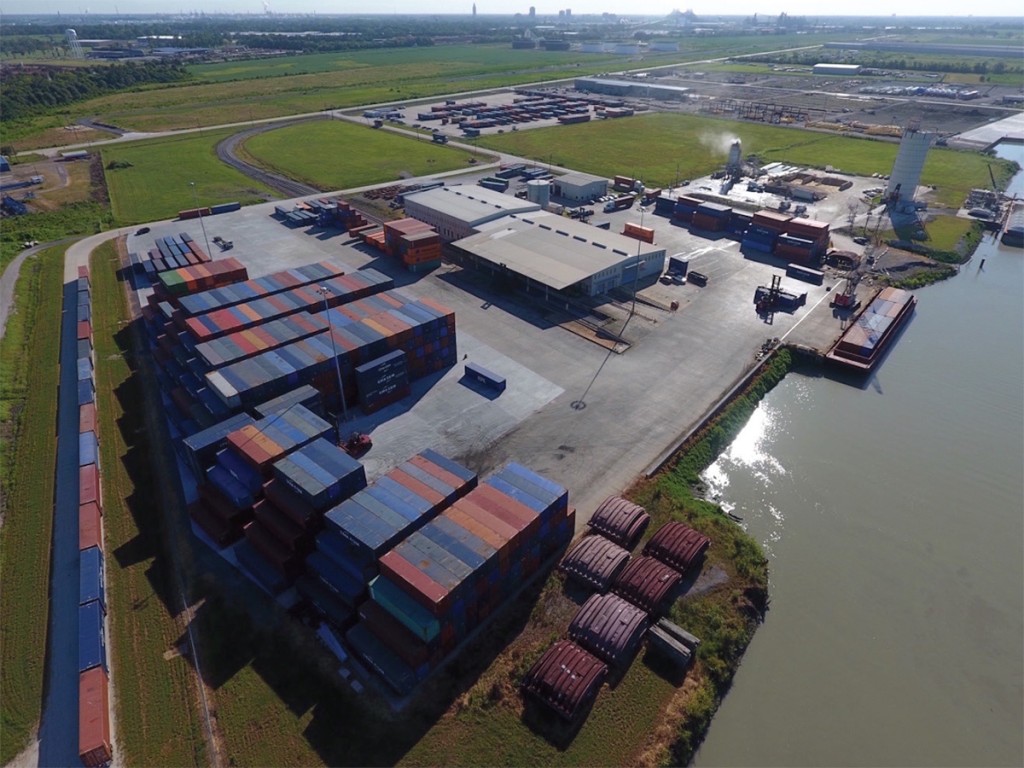
Port of Greater Baton Rouge, LA
The Port of Greater Baton Rouge has a fortuitous location at the convergence of the Mississippi River and the Gulf Intracoastal Waterway. It is both a port of call for ocean ship traffic — Panamax ships can call — and Mississippi River barge services as the port is adjacent to the Port Allen Lock, which is the northernmost point on the Mississippi River where barges can access the Gulf Intracoastal Waterway.
This combination of traffic places the Port of Greater Baton Rouge (which operates Port Allen) among the largest in tonnage terms in the United States. The combination of private and public facilities regularly hit nearly 80 million tons of cargo ranking in the nations top ten. In 2021 the public terminals alone handled nearly 16 million tons.
Through a public/private partnership between the port and SEACOR AMH the number of containers handled at the barge terminal has steadily increased and as a result an additional 4 acres of paved container storage space was added. The yard now can handle around 2,000 containers including both 40 and 20 footers.
Another addition made to the port in 2022 was a specially designed pedestal crane mounted on a barge. The barge/crane is used by the Louis Dreyfus Company’s grain elevator during periods of high and low water to help unload grain barges shipped on the Mississippi River. The electrically powered crane can move 25 yards of grain with each scoop of the clam-shell bucket. The cost for the barge-crane was $7 million, paid by the State’s capital outlay program.
Port of Lake Charles, LA
On February 9th the U.S. Transportation Secretary Pete Buttigieg, Louisiana Governor John Bel Edwards and Louisiana Secretary of Transportation Shawn Wilson visited Lake Charles to celebrate a $150 million grant to help replace the Interstate 10 Calcasieu River Bridge. According to Wilson, the grant from the Bipartisan Infrastructure Law will be followed up with $1.5 billion in private bonds to help lower the project cost for the engineering company’s work. The 70-year old bridge was created to handle 37,000 crossings a day but now has more than 80,000 daily crossings, according to Wilson.
In terms of annual tonnage, the Port of Lake Charles [officially, the Lake Charles Harbor and Terminal District] and one of the nation’s largest industrial port complexes, featuring LNG [top U.S. LNG export area], liquid and dry bulk, breakbulk and project cargo.
The port manages the Calcasieu Ship Channel, which runs inland 36 miles and extends out into the Gulf of Mexico another 32 miles.
And, quite aside from the Calcasieu River Bridge, the Lake Charles area is booming with projects. More than $108 billion in industrial projects have been completed, underway or announced on and around the port and Calcasieu Ship Channel areas. A total of $41 billion in projects planned over the next few years.
Although the port already has a diverse menu of services it is looking to “capitalize on a rapidly changing market.” Ricky Self, port executive director, says his biggest future need will be enhancing port facilities to prepare for a burgeoning offshore wind market. The port’s Industrial Canal site “checks all of the boxes,” Self says. “The Bureau of Ocean Energy Management has proposed the first offshore wind lease in the Gulf,” he adds, “and the majority of the acreage sits just 30 miles from where the Calcasieu Ship Channel hits the Gulf.”
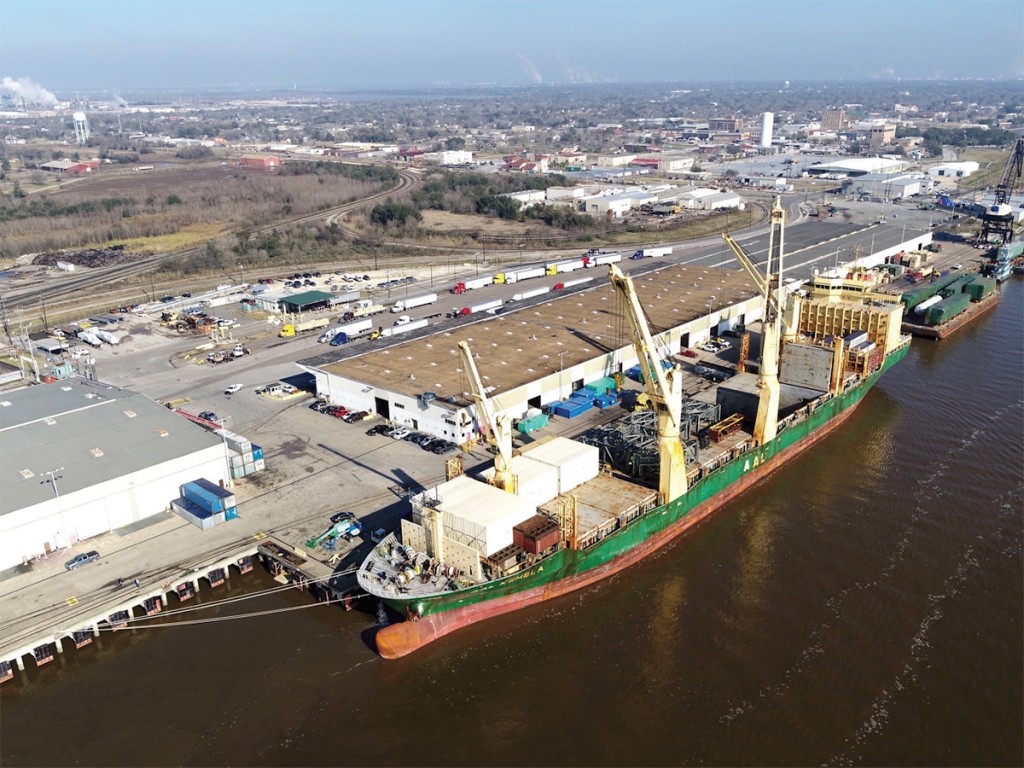
Port Arthur, TX
Diversified cargo is a key to success for the Port of Port Arthur.
Anthony Theriot, director of trade development, broadly notes to AJOT that at this Texas seaport, “We have an even mix of export and import cargo with the main commodity being forest products. The port also handles aluminum, project cargo, and low sulfur diesel.”
He adds that Port Arthur (POPA) has the distinction of being a Strategic Military Port, “handling military cargo for our nation’s armed forces.”
POPA in the last few years has received a few grants to help improve its infrastructure. So, it is working with $150 million in capital expansion projects. In 2022, it completed a 600-foot expansion of its berth five and will complete a 1,000-foot berth six expansion in the first quarter of 2024.
“This will enable the port to handle more vessels and create jobs for our local community.”
“We just received $13.6 million from the U.S. Department of Transportation Rebuild American Infrastructure grant which provides funding for surface transportation projects,” Theriot says. “This grant will help in many ways.” This will enable the port to stabilize 25.2 acres of land for laydown cargo, plus add an additional 2.2 acres for a truck queuing and staging area. It will also improve storm sewer, fiber and utility connections, lighting, and gating areas.
There is yet another grant that will take down Shed One which is a metal clad building to be replaced by a pvc membrane facility for more square footage and more cargo stacking height.
Meanwhile, POPA’s breakbulk port is expanding, creating local jobs for the community, and creating value for customers.
Theriot closes his comments, noting: “We must give credit to our employees who worked throughout COVID. During this time, we have doubled the amount of man hours worked and have continued since. Our people make the difference.”
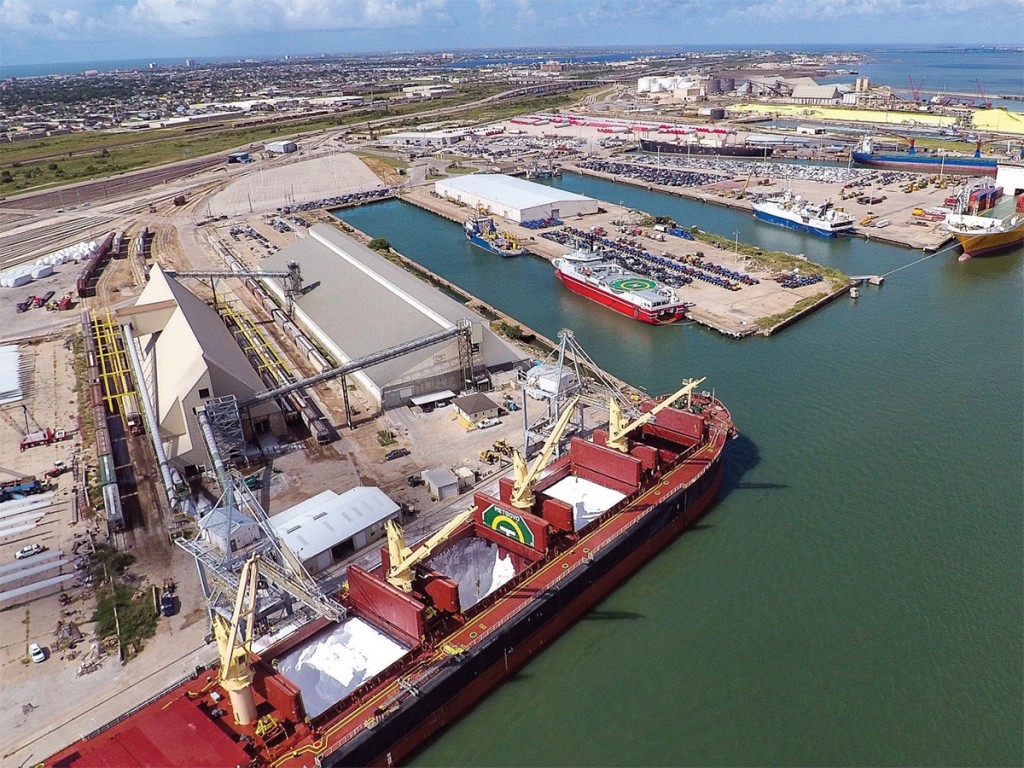
Port Galveston, TX
The Port of Galveston is off to a strong start in 2023. When comparing February 2023 numbers to the same time last year (2022), performance is up for cargo and cruise, according to Rodger Rees, Galveston Wharves port director and CEO.
In his report Rees notes, “Cargo tonnage was up almost 44% this February compared to the same time last year. Bulk grains, fertilizer, liquid bulk, roll-on/roll-off cargo, and new cars are all dramatically up. Cargo ships calling at the port totaled 52, a 13% increase over February 2022.
Lay ship calls, another revenue generator for the port, were up 10%, with 55 ship calls compared to 50 for the same time last year.”
Another strong segment for the port in the 1st Qtr was the cruise business, which was up 72% compared to February 2022 notching 71 cruise sailings and 521,503 passenger movements (embarkations and debarkations), up a staggering 123%. The early totals suggest that the port could break the record 1 million passengers.
According to Rees, “Galveston is on track to issue $100 million in bonds to help fund much-needed, time-sensitive projects, including expansion of the West Port Cargo Complex, major improvements to the Pier 25 cruise terminal, and construction of a proposed fourth cruise terminal at Pier 16.”
The port’s already working on improvements at Cruise Terminal 25 to prepare for the arrival of Carnival’s new, larger ship, the Jubilee, in December. And in anticipation of a partnership agreement with MSC to build a new cruise terminal and parking garage at Pier 16, the port’s initiating preliminary studies for project scope, budget, and design. The fourth cruise terminal is included in the port’s 20-Year Strategic Master Plan, adopted by the Wharves Board in 2019.

Port of Houston, TX
Many uncertainties for the global economic outlook, for which China’s future is one of the main wild cards, with a struggling property sector and a policy shift from focusing on economic growth above all else, explain a drop in 2023 business at the Port of Houston, TX.
As he cites positives at the port this year, Randy Stiefel, director of multi-purpose facilities for the Port of Houston, also acknowledges that, as of March 2023, Houston’s year-to-date general cargo had a total decline of 18%.
Still, Houston’s tonnage numbers are huge. The latest U.S. Corps of Engineers report this spring shows the Houston Port Authority in 2021 had the greatest tonnage of any U.S. seaport. Houston handled 266.5 short tons of total trade. Of this, 190.7 million tons were imported product.
Pipe and steel imports are the bread and butter of Port Houston. “When oil prices go up, we are busy. And oil is $80 a barrel now.” So, business is good, Stiefel tells AJOT.
“Houston handles a wide variety of steel. We have had a great year last year, but it was not a record for steel.” He says 99.9% of the port’s steel business is imported product.
Houston also enjoys a wide base of general cargo. This includes lumber and “super sacks” of cement, which are efficiently shipped in bulk cargo ships. This cement is primarily sourced in Egypt and Turkey.
Stiefel says that Houston has also enjoyed a “tremendous amount” of aluminum cargo in the past year.
“We’re very excited” about the variety of general cargo to supplement Houston’s core business of steel. “Seeing a wide range of cargo, not just steel” brings strength through diversification.
Stiefel wrote in a mid-May memo to AJOT that charter rates continue to weaken with increasing competition for cargoes from the container and bulk carrier sectors. The charter market is expected to remain healthy mainly due to project cargo demand.
The large fall in day rates compared to the 2022 peak for container ships and dry bulk carriers and competition for cargoes has resulted in multi-purpose vessels (MPV) also suffering a decline, he says. “The robust project cargo demand is only slowing the decline, and we still expect rates to fall further in 2023-24. MPV day rates to remain above pre-COVID levels.”
The outlook for MPV demand remains steady for the long term with an average growth of 1.9% per year to 2027. The renewable energy industry will be one of the most important drivers of MPV demand in the following years despite a weaker environment for global economic growth. The proportions of containerized, dry bulk and non-containerized general cargo carried on MPVs have been fairly stable in the long term, except for containerized cargo in 2021 seeing a strong increase due to the supply-demand imbalance of container ships caused by congestions.
This meant that MPVs were able to take advantage of the overspill, but those capacity issues have unwound since then.
First quarter 2023 remained the same as 2022: Newbuilding activity remains limited with only five new orders reported in the first quarter of 2023. Smaller-sized vessels and large-crane-capacity Project carriers are the winners when it comes to orders in this segment. Mid-sized MPVs with low crane capacity have not made it to the orderbook for over two years.
Stiefel says seaborne trade of forest products increased strongly in 2022 and 2023. Forest products is a diverse group of commodities, ranging from pulp and paper to logs, with every type of wood in between.
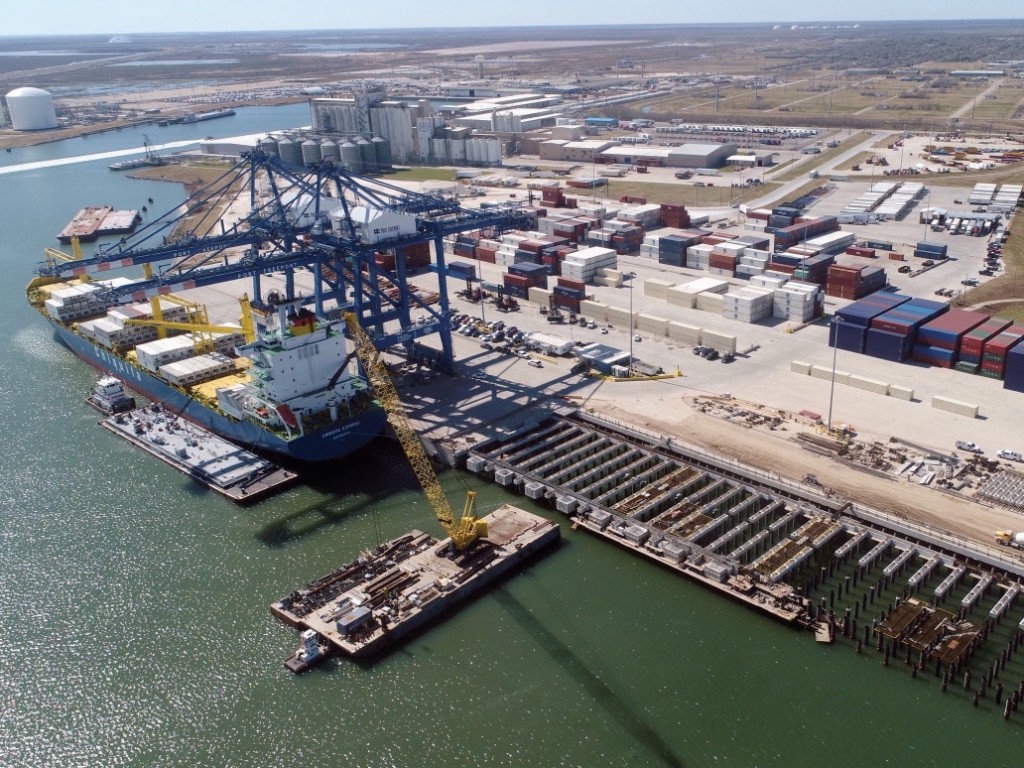
Port Freeport, TX
A great deal has been happening in Freeport. Starting back in October of 2022, when Volkswagen Group of America, Inc. (VWGoA) announced Port Freeport as the new major Gulf Coast hub for its future vehicle logistics port operations, in collaboration with Port Freeport and developer PRP and KDC. With a 20-year lease agreement, VW of America aims to improve vehicle logistics efficiency further and to increase importation capacities to serve nearly 300 dealers in the United States. The new port facilities are set to be operational in early 2024.
Port Freeport ro/ro carriers calling the port include Hoegh Autoliners, Glovis, Liberty Global Logistics, Sallaum and Grimaldi Lines, Port Freeport’s resident OEM Terminal Operator and partner Amports.
On April 25th the Port of Freeport and Dole Fresh Fruit, celebrated 40 years of partnership. Dole expanded their operations to Port Freeport in April 1983. In 2021, Dole deployed the newly built DOLE AZTEC and DOLE MAYA container vessels to their Gulf Express service calling Port Freeport. In 2022, Dole supplied over 10.5MM boxes of bananas to North America through Port Freeport.
The port is also in the process of finishing the widening and deepening of the Port Freeport Ship Channel. The work is expected to start this summer, will take 700 to 800 days of dredging to complete and should meet the goal of having the full project done by the time the port celebrates its 100th anniversary in 2025. The final phase is estimated to cost about $146 million, with $55.8 million remaining in voter-approved bonds to pay the port’s share. U.S. Army Corp of Engineers (USACE) received a $90.6 million allocation for the project in the omnibus spending bill passed by Congress late in 2022.
The channel deepening project is a strategic initiative for Port Freeport.
The first dredging contract deepened the segment of the Freeport Harbor Channel adjacent to the Port’s Velasco Container Terminal, referred to as Reach 3, to 51 feet making way for larger, deeper-draft vessels to call Port Freeport.
A second contract to widen the narrowest section of the Freeport Harbor Channel to 400 feet (Reach 2 Widening) was completed in April 2022 improving navigation safety for vessels transiting the channel.
The port also has new liner service. The new service is Oceanus Line’s Florida Gulf Express (FGX), initially fortnightly (every two weeks), operates counterclockwise from Cartagena, Colombia, to SeaPort Manatee, then across the Gulf of Mexico to Port Freeport, before heading south to Veracruz, Mexico, and returning to Cartagena. On the inaugural voyage, the vessel called at the Mexican port of Tuxpan on its way north from Colombia. Oceanus Line’s X-Press Cotopaxi, with a capacity of 1,740 TEUs is the vessel serving the route.
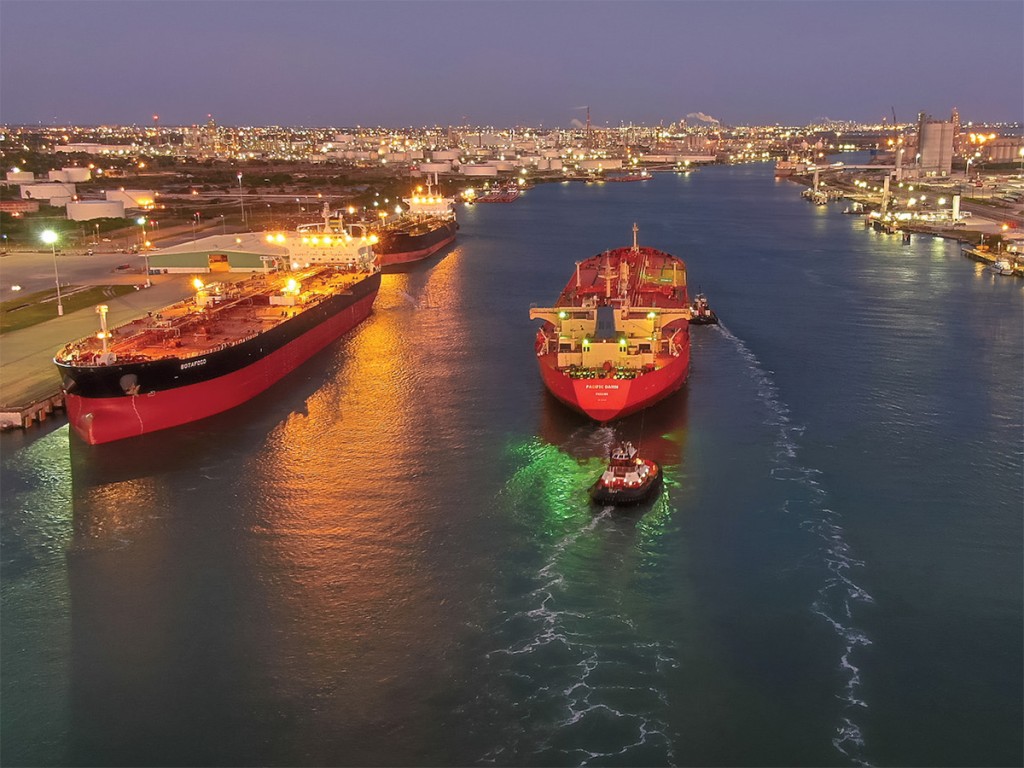
Port of Corpus Christi, TX
Although the U.S. economy may be in a tepid spell, that isn’t the case for the Port of Corpus Christi. The port in the first quarter of 2023 (Q1-2023) posted a record tonnage of 49.6 million tons, surpassing the year-over-year (YOY) period in 2022 by more than six million tons and inching past the previous quarterly record of 49.5 million tons set in Q4-2022. March saw the best month ever for the Port of Corpus Christi – with over 17.5 million tons of cargo moving through the gateway.
Crude oil paved the way with a 24.3% YOY increase, with crude oil exports hitting a record 2.3 million barrels per day. Additionally, refined products saw a significant increase at 6.3% compared with March 2022. LNG hit 4.2 million total tons in Q1-2023 versus Q1-2022. However, LNG exports are expected to grow as Cheniere’s Corpus Christi Liquefaction facility currently is undergoing a 12 million ton per year capacity expansion with new volumes expected to come online sometime in late 2024 or early 2025.
“The Port of Corpus Christi and our customers continue to drive more energy-related tonnage through the gateway, demonstrating confidence in the organization and our infrastructure investments, which have increased the economic resiliency of the region, the state of Texas and the Nation,” said Sean Strawbridge, chief executive officer for the Port of Corpus Christi and chairman of the American Association of Port Authorities (AAPA). “While the International Monetary Fund (IMF) and Federal Reserve have indicated the possibility of a global recession, we remain optimistic the strategy of adding new energy transition related projects to our portfolio, while continuing the support of traditional energy markets, is a sure bet for both today and in the years ahead.”
Earlier this year, the Port of Corpus Christi was awarded $16.4 million in grant monies through the U.S. Department of Energy’s (DoE) Carbon Storage Assurance Facility Enterprise (CarbonSAFE) initiative. These grants will help the port evaluate the feasibility of permanently storing captured carbon dioxide (CO2) from industrial operations – potentially accelerating the development of a centralized solution to capture and manage CO2 emissions, a key component of the Biden Administration’s Inflation Reduction Act.
The Port of Corpus Christi also has created an Integrated Regional Clean Hydrogen Hub and submitted the application to the DoE in early April.
“As the Energy Port of the Americas, the Port of Corpus Christi remains committed to serving our existing customers and attracting new business to the energy landscape of South Texas,” said Charles W. Zahn Jr., Port of Corpus Christi Commission chairman. “We have our eye on the bigger picture, which is generating and sustaining more jobs in Texas.”
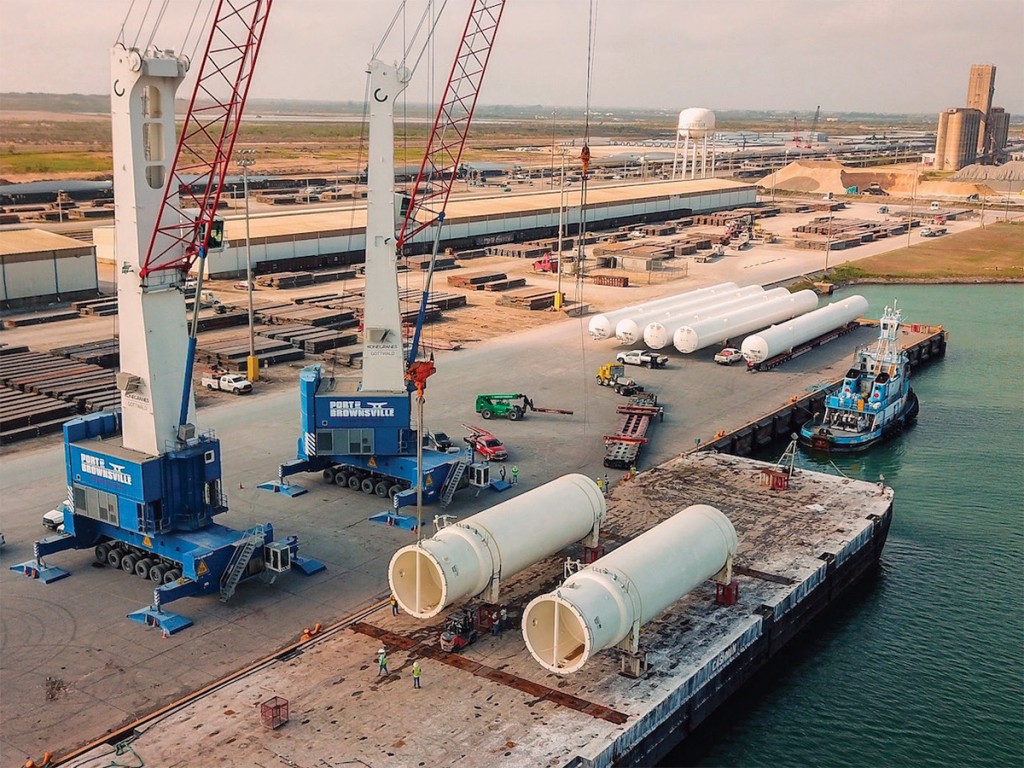
Port Brownsville, TX
Ocean freight volumes for the Port of Brownsville, TX, have increased every year since 2020’s COVID pandemic. Port Director and CEO Eduardo Campirano tells AJOT that Brownsville’s tonnage was up in 2021 and again in 2022. So far in 2023, the deep-south Texas port is enjoying even greater ocean trade volumes. “We saw increases in our numbers and we’re still trending upward.”
The latest – 2021 - U.S. Army Corps of Engineers report on U.S. seaport tonnage released this spring, showed that Brownsville had a 30% jump in volume from 2020 to 2021. “That is exciting for us,” Campirano indicates. According to the report, Brownsville moved up in national seaport tonnage ranking from 66 to 55. The list ranks the country’s largest 150 seaports. The 2022 figures, when published, are expected to show another big jump for Brownsville. “We will see quite a leap.”
The increased business is attributable to existing customers’ ongoing success. These customers handle steel, which is processed in many forms. Project cargo from the wind energy business also continues to thrive in Brownsville, and the hydrocarbon business is also flourishing. “They all are seeing increases with us. We continue to see growth with existing customers.”
A boost to the port is the construction of the state-of-the-art Forza Steel manufacturing facility.
Prep work to finalize Forza’s work is “blowing and going,” Campirano enthusiastically notes. The $60 million facility should be fully operational by the fall of 2023. The facility has different production phases, with the first of those expected to be operational this July.
The Mexican company Forza specializes in manufacturing carbon steel pipe but will produce a wide range of products ranging from round and square tubing to products to serve a variety of industries, including automobiles, oil, and gas. Steel products manufactured by Forza will be shipped overland to customers in the United States and Mexico.
Forza expanded beyond its plant in Salinas Victoria, Nuevo Leon, with Brownsville, which was selected to enhance operations in the U.S. by getting closer to their customer base to close gaps in the supply chain.
Eventually Forza may export products by sea from the Port of Brownsville, but for now service to the two immediate markets is the plan.
Forza Steel is among the latest companies to join the port’s growing steel sector, bringing in 150 direct jobs and 450 indirect jobs to the region. The new 650,000-square-foot facility will manufacture steel pipes and tubes for the automotive, construction, and oil and gas industries.
“We are excited to expand our role in the steel industry as a major gateway for steel in both Mexico and the United States,” Campirano notes.





